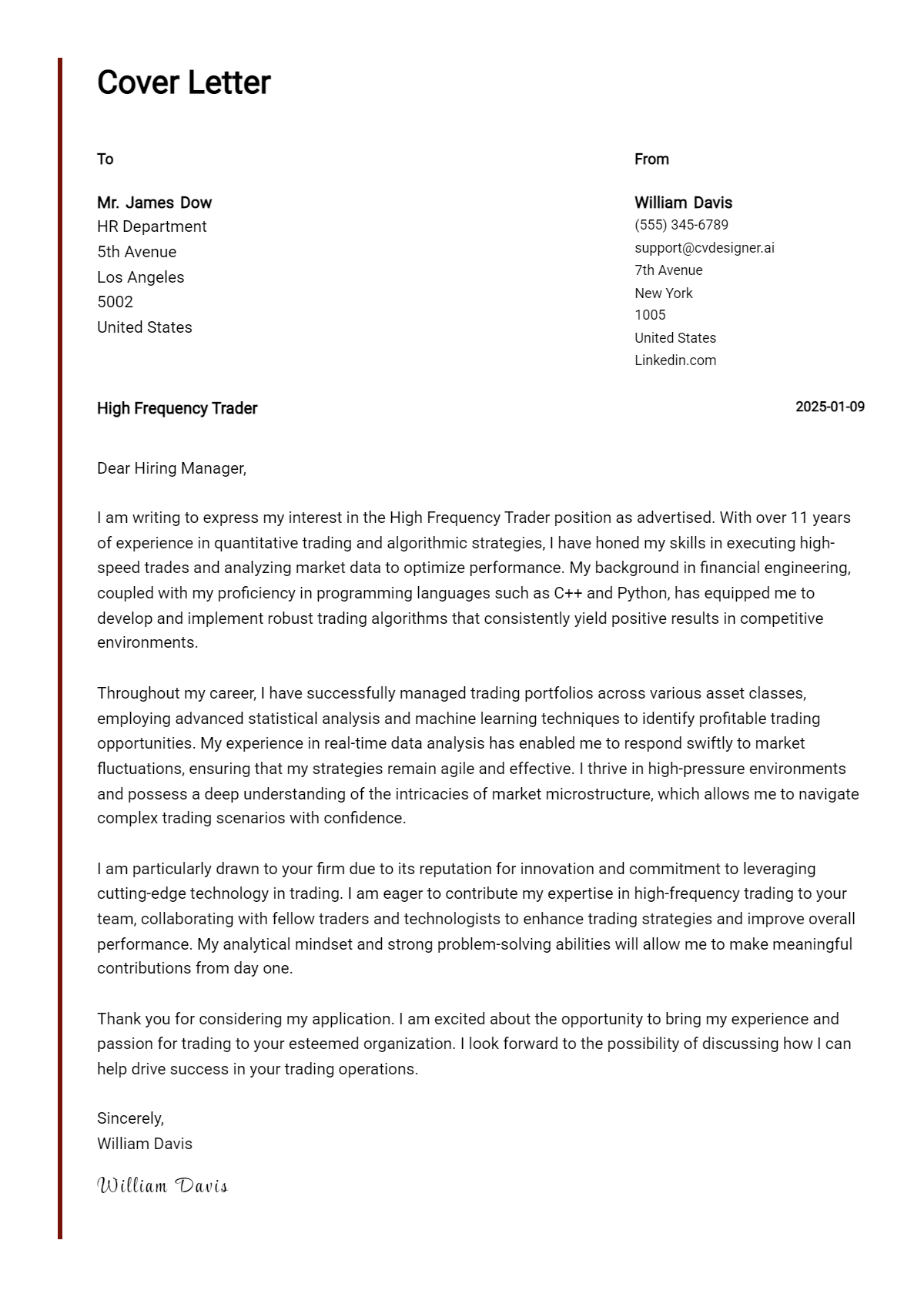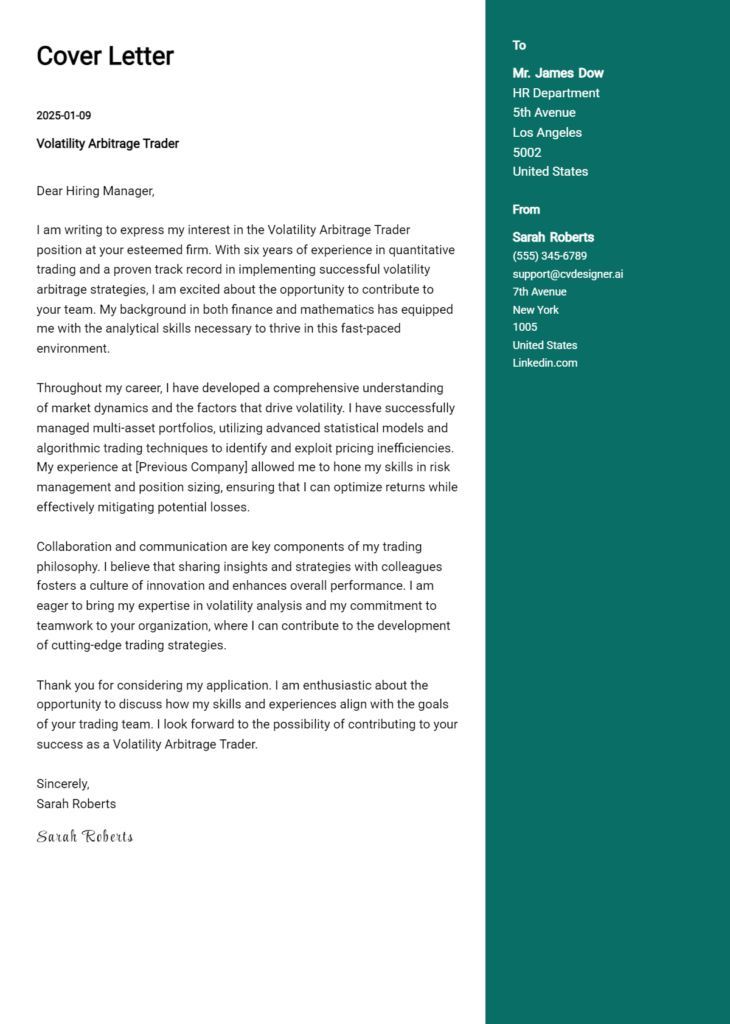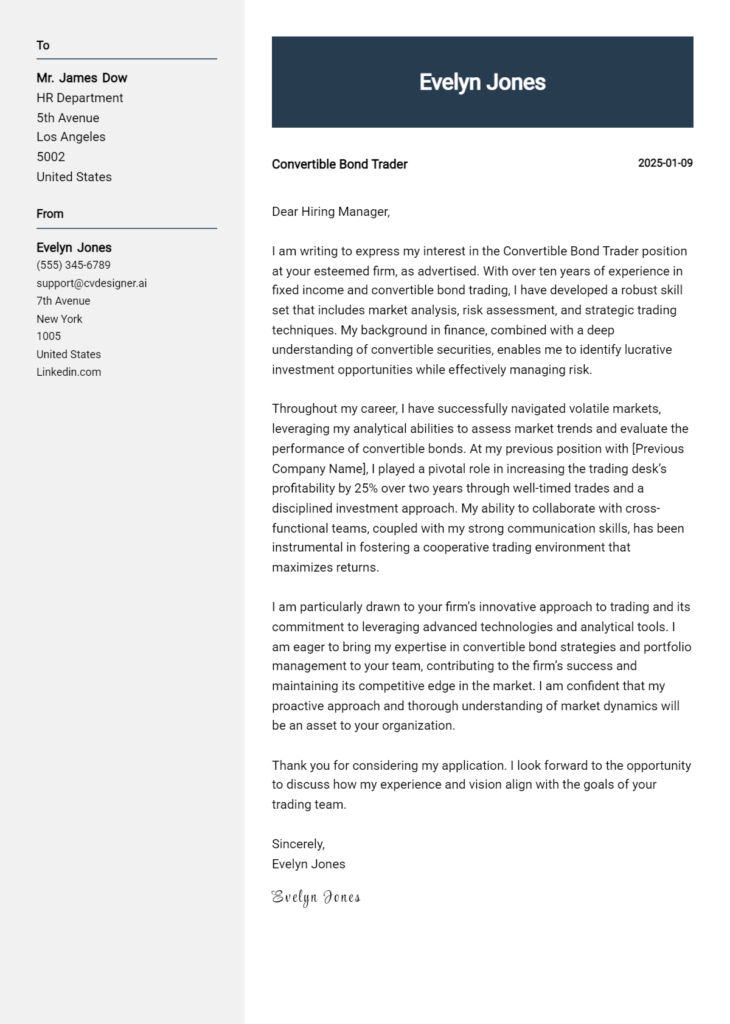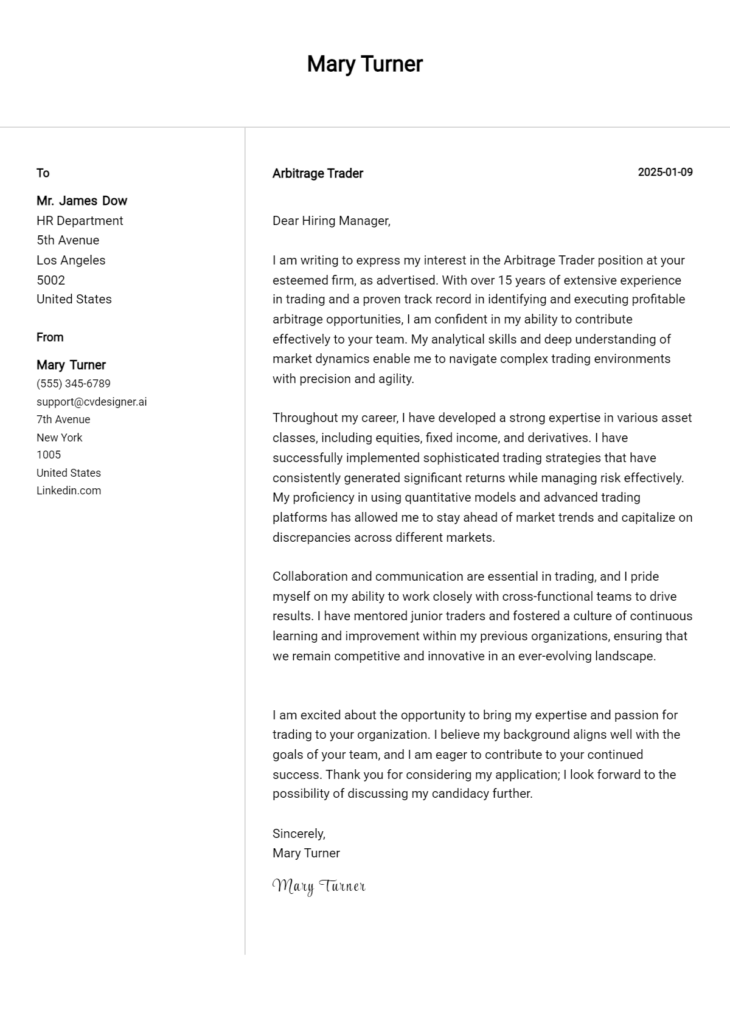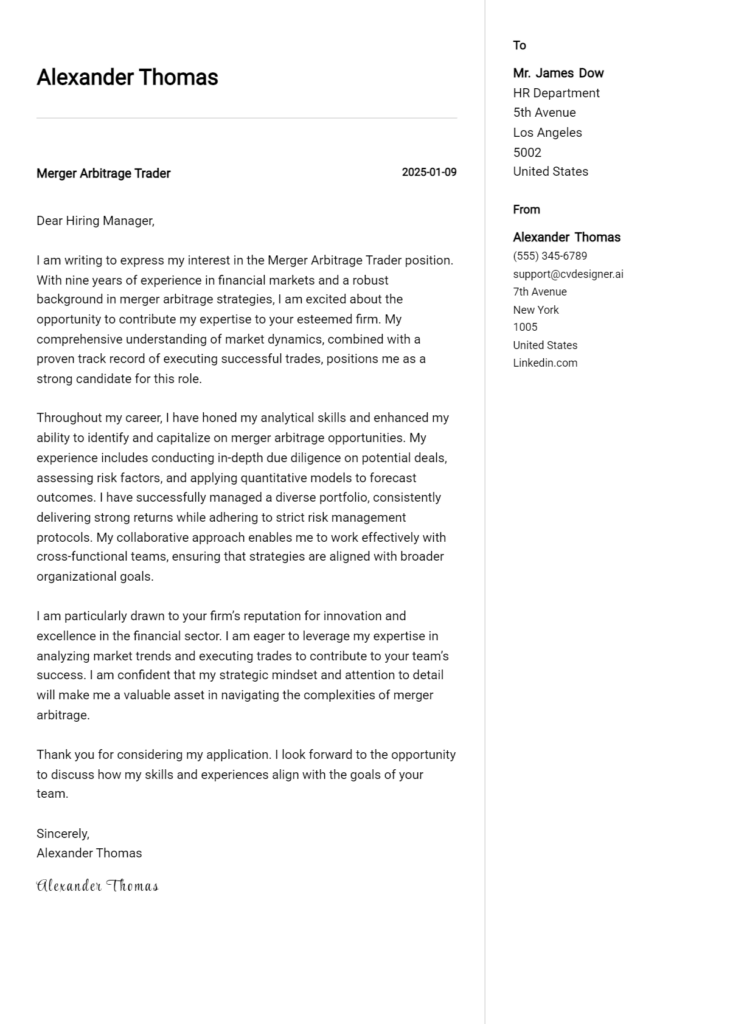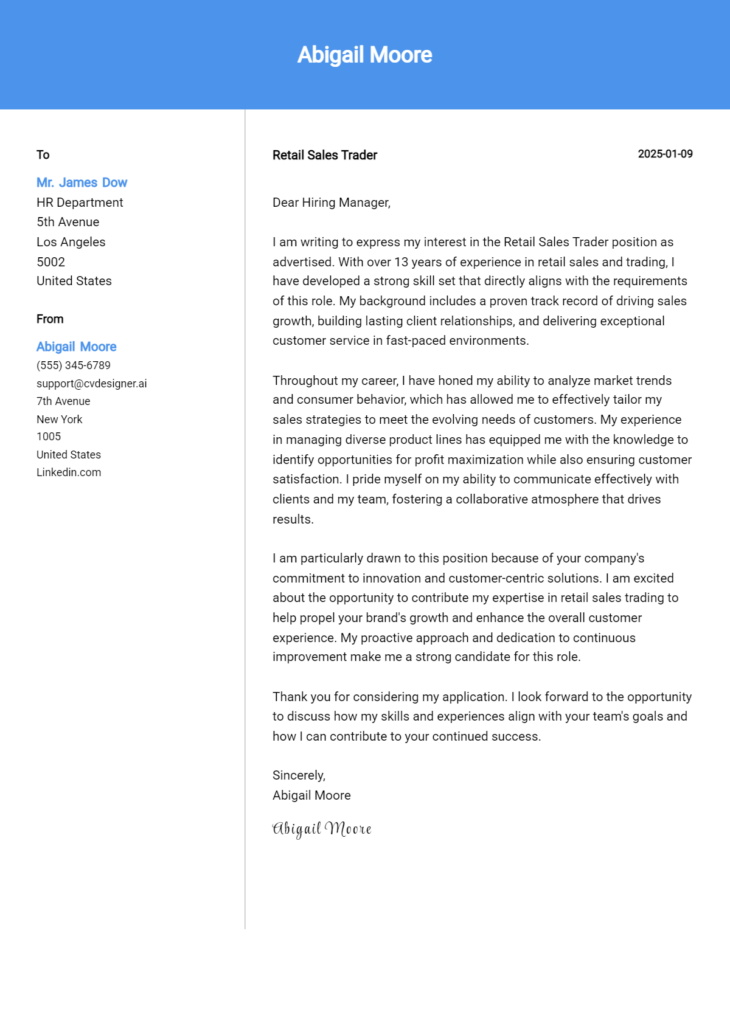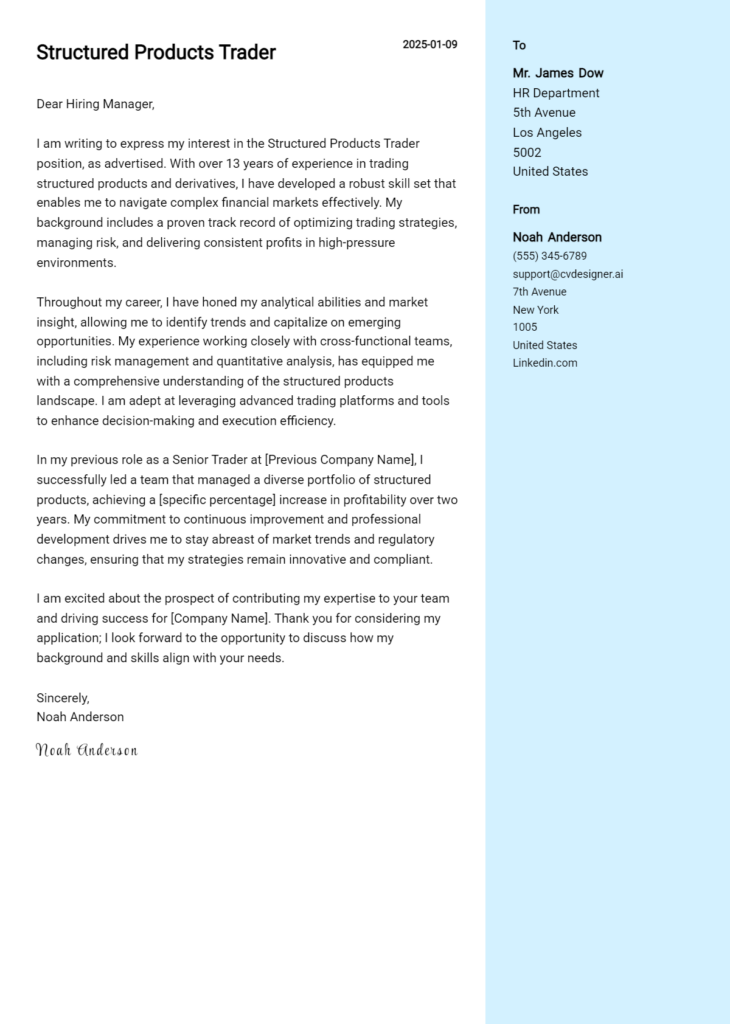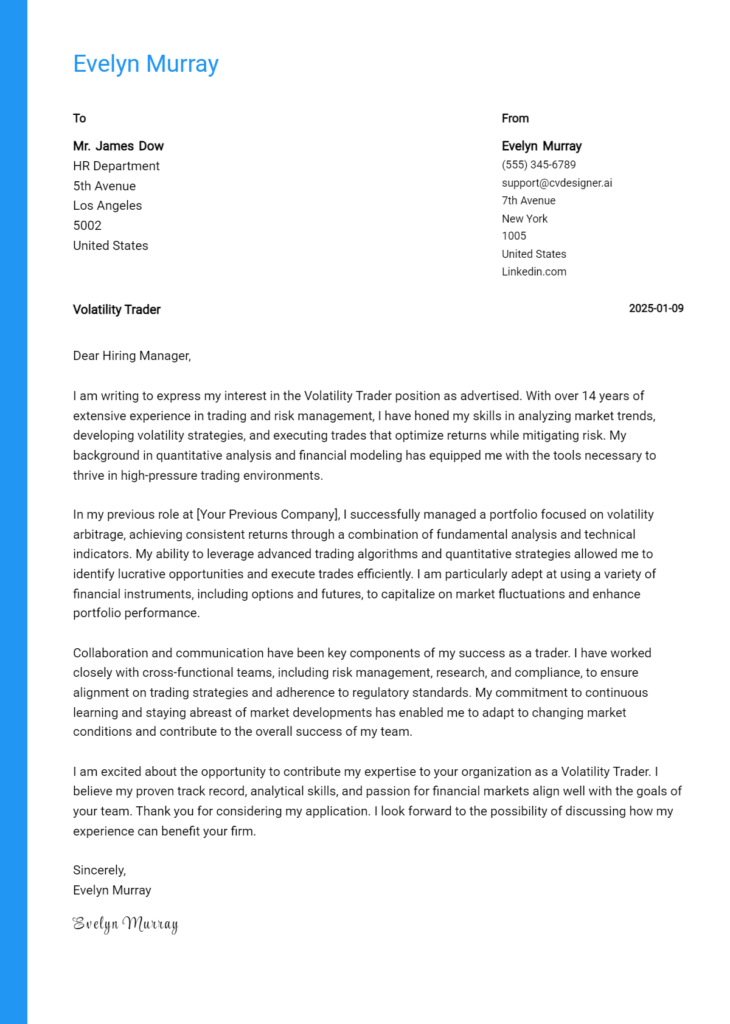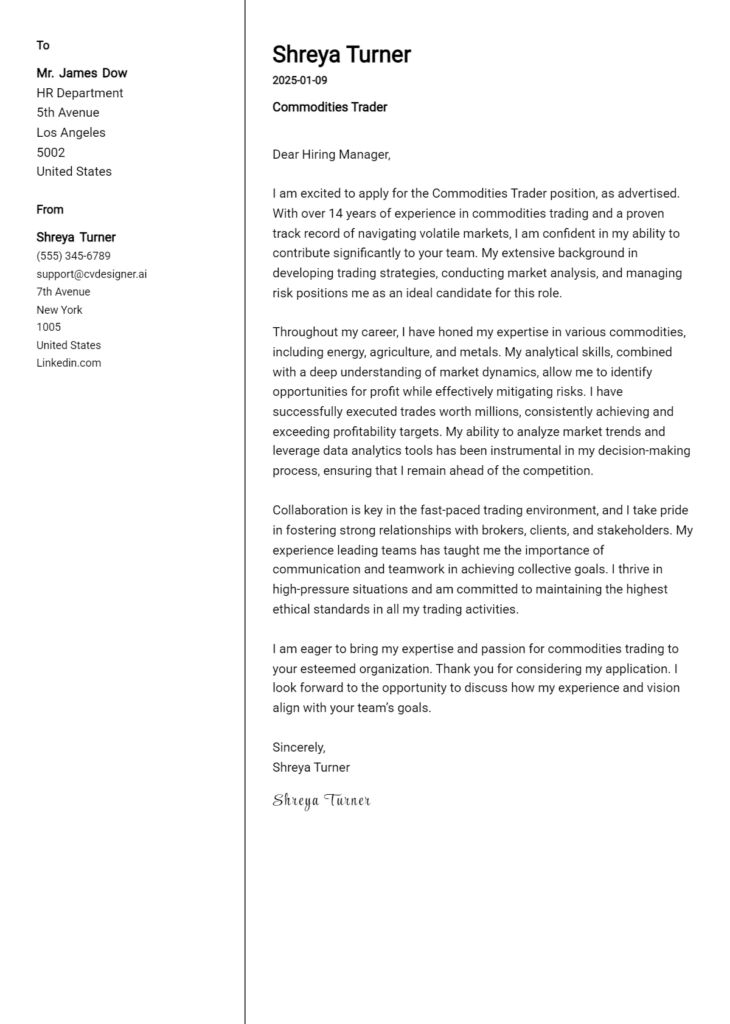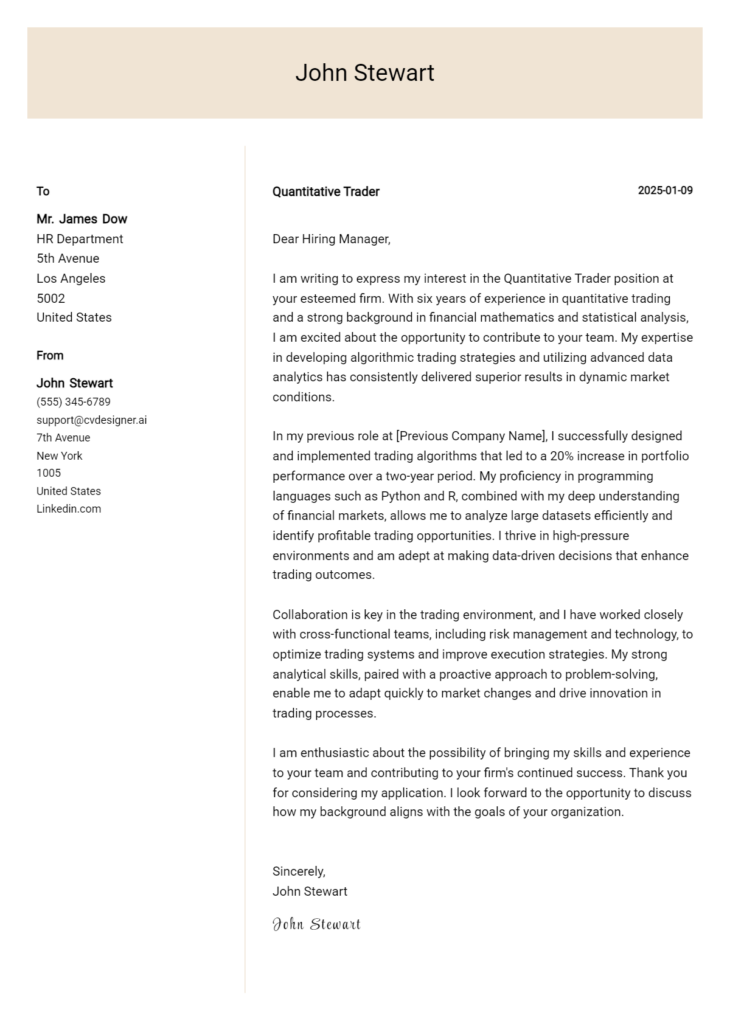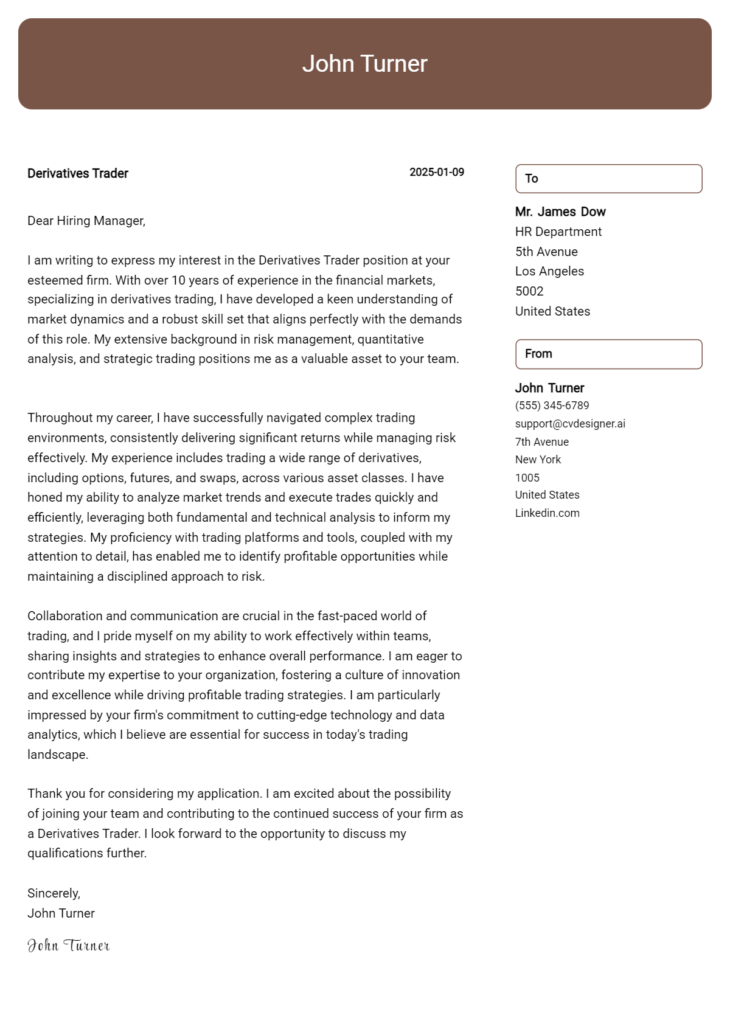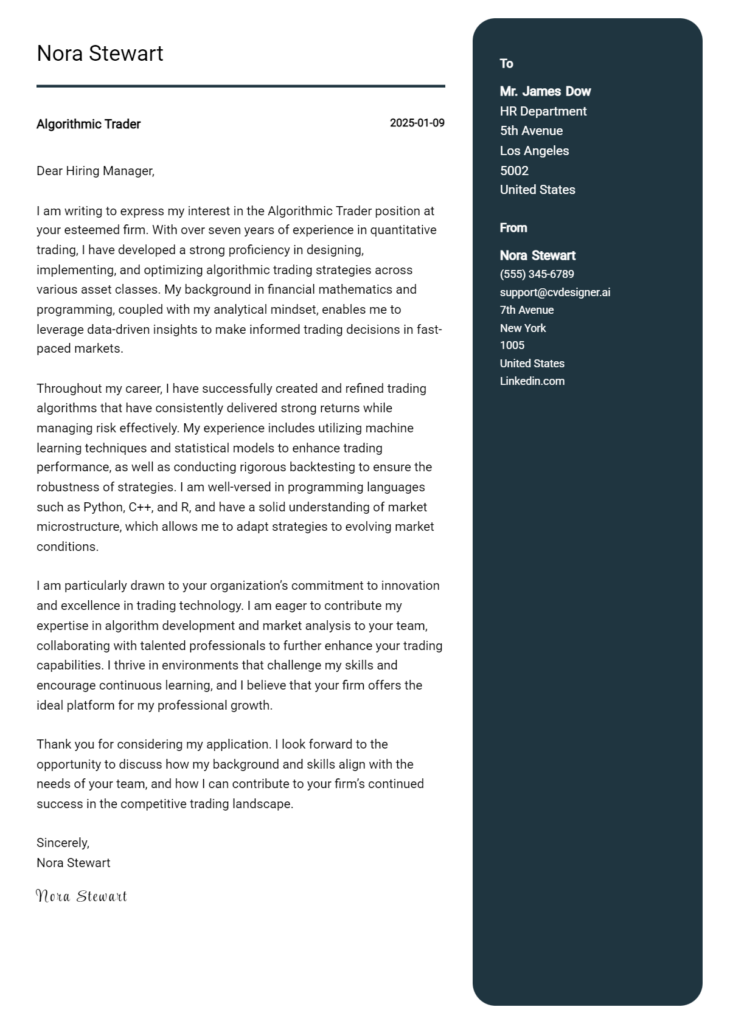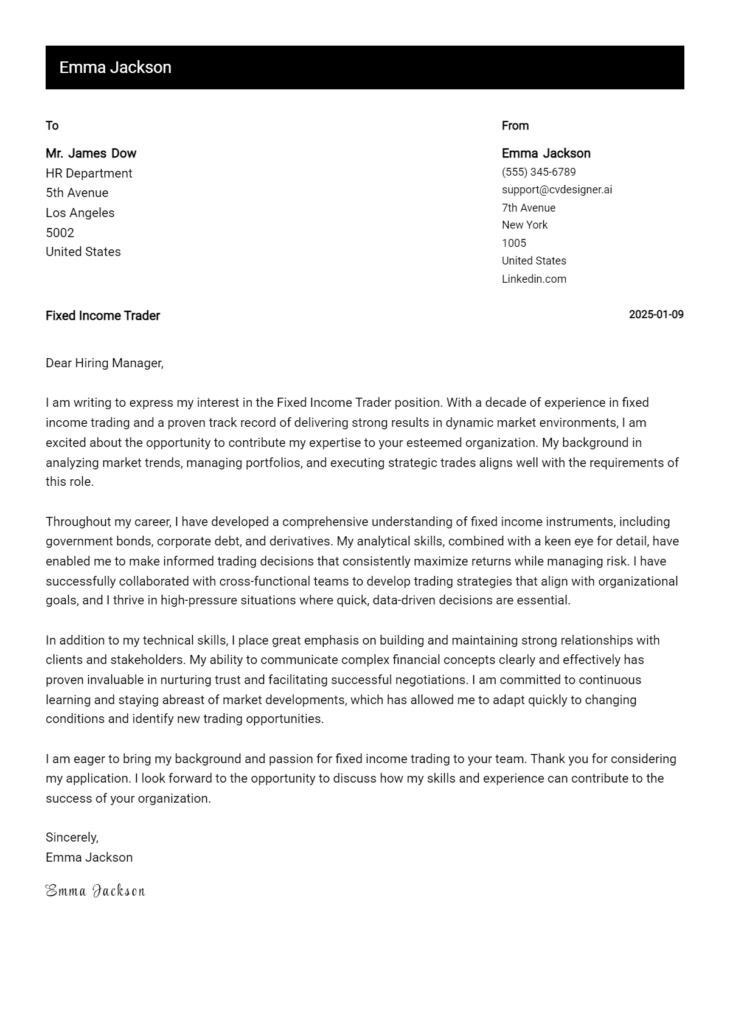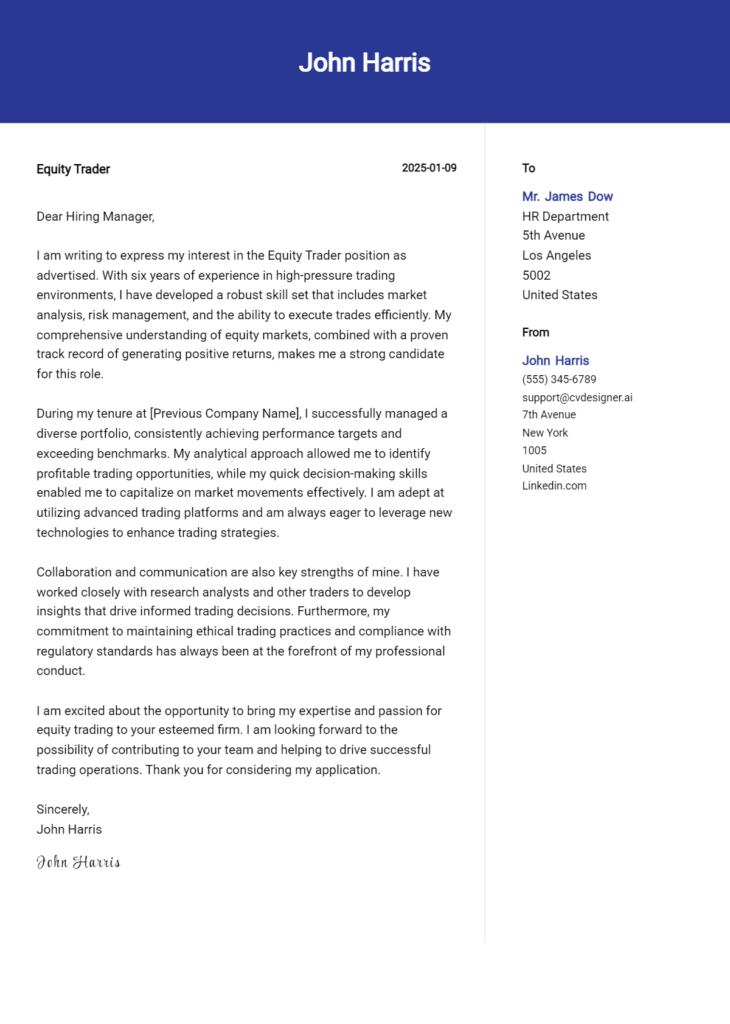High Frequency Trader Cover Letter Examples
Explore additional High Frequency Trader cover letter samples and guides and see what works for your level of experience or role.
How to Format a High-Frequency Trader Cover Letter?
Crafting a compelling cover letter for a High-Frequency Trader position is essential, as it serves as your first impression in a highly competitive field. The way you format your cover letter not only reflects your technical skills but also your ability to communicate effectively and pay meticulous attention to detail—attributes that are paramount in trading environments where every millisecond counts. A well-structured cover letter can captivate hiring managers, showcasing your analytical capabilities and strategic mindset.
In this guide, we will outline how to format your cover letter, providing insights and specific examples tailored for the high-frequency trading industry.
We will focus on the key components of a professional cover letter, including:
- Cover Letter Header
- Cover Letter Greeting
- Cover Letter Introduction
- Cover Letter Body
- Cover Letter Closing
Each section is crucial for demonstrating your qualifications and professional demeanor. Let’s delve into the specifics of each part to help you create a standout cover letter for your high-frequency trading career.
Importance of the Cover Letter Header for a High-Frequency Trader
The header of a cover letter is a crucial component, particularly for a High-Frequency Trader, as it sets the tone for the application and reflects professionalism. A well-structured header provides essential information at a glance, ensuring clarity for the recipient. It should include your contact information, the date, and the recipient's details. A clear and professional header not only shows attention to detail but also helps to establish your credibility in a competitive field where precision is key.
Here are examples of a strong and weak cover letter header for a High-Frequency Trader:
Strong Example:
John Doe 123 Trading Lane New York, NY 10001 johndoe@email.com (123) 456-7890 October 1, 2023 Jane Smith Hiring Manager XYZ Trading Firm 456 Market St New York, NY 10002
Weak Example:
JD NY johndoe@email.com 10/1/23 XYZ Firm
In the strong example, the header is complete and presents the information clearly and professionally, while the weak example lacks detail and clarity, which could leave a negative impression on the recipient.
The Importance of a Strong Cover Letter Greeting for a High-Frequency Trader
A well-crafted cover letter greeting serves as the first impression for your application, setting the tone for the entire letter. It reflects your professionalism and attention to detail, which are critical traits for a High-Frequency Trader, where precision and quick decision-making are paramount. By addressing the hiring manager directly, you personalize your communication and demonstrate genuine interest in the position and the organization. To make a positive impact, avoid generic greetings such as "To Whom It May Concern." Instead, take the time to research the recipient's name through the company website or LinkedIn. This small effort can significantly enhance your appeal as a candidate. Below are examples of strong and weak greetings that illustrate this point.
Strong Example
Dear Ms. Smith,
Weak Example
To Whom It May Concern,
The Importance of a Captivating Cover Letter Introduction for a High-Frequency Trader
A well-crafted cover letter introduction is essential for a High-Frequency Trader position, as it serves as the first impression for the hiring manager. This introduction should not only capture their attention but also express genuine interest in the role and briefly showcase key skills or achievements that align with the job requirements. A compelling introduction sets the stage for the rest of the cover letter, creating a strong foundation for candidates to demonstrate their expertise in fast-paced trading environments. Below are examples of both strong and weak cover letter introductions to illustrate the difference.
Strong Introduction Example
Dear [Hiring Manager's Name], As a passionate and results-driven High-Frequency Trader with over five years of experience in algorithmic trading and quantitative analysis, I was thrilled to come across the opportunity at [Company Name]. My ability to leverage cutting-edge technologies and develop high-performance trading algorithms has consistently resulted in substantial profit margins, including a 30% year-over-year increase in returns for my previous firm. I am eager to bring my expertise in statistical modeling and risk management to your team and help [Company Name] maintain its competitive edge in the market.
Weak Introduction Example
Hi, I saw the job opening for a High-Frequency Trader at your company, and I think it sounds interesting. I have some experience in trading, and I believe I might be a good fit. I like numbers and am looking for a new job.
Purpose of the Cover Letter Body for a High-Frequency Trader
The cover letter body for a High-Frequency Trader serves as a critical component in demonstrating the candidate's specialized skills, relevant experiences, and overall value to the prospective employer. It provides an opportunity to highlight specific projects or accomplishments that directly relate to high-frequency trading, such as successful algorithm development, significant improvements in trading strategies, or contributions to risk management practices. By articulating quantifiable achievements and showcasing technical expertise, the candidate can effectively differentiate themselves from other applicants and convey their potential impact within the organization.
Strong Example
Dear Hiring Manager, I am excited to apply for the High-Frequency Trader position at XYZ Trading Firm. In my previous role at ABC Investments, I developed a proprietary algorithm that improved trade execution speed by 30%, resulting in a 15% increase in annual profits. Additionally, I led a team that successfully backtested over 500 trading strategies, identifying the top-performing algorithms that contributed to a 20% reduction in trading costs. My ability to analyze large datasets and apply machine learning techniques has consistently delivered superior returns, and I am eager to bring my skills to your innovative trading team. Sincerely, John Doe
Weak Example
Dear Hiring Manager, I want to apply for the High-Frequency Trader position. I have some experience in trading and know a bit about algorithms. In my last job, I worked with a team, and we did some trading. I think I could help your company make money. I am good with numbers and love the stock market. Best, John Doe
Importance of the Cover Letter Closing for a High-Frequency Trader
The closing of a cover letter is crucial, especially for a role as competitive and technical as a High-Frequency Trader. This section should effectively summarize your qualifications, reiterate your strong interest in the position, and encourage the hiring manager to take the next steps, such as reviewing your resume or scheduling an interview. A well-crafted closing leaves a lasting impression and can influence the decision-making process, highlighting your enthusiasm and professionalism.
Strong Example
Thank you for considering my application for the High-Frequency Trader position. With my extensive background in quantitative analysis and algorithmic trading strategies, I am excited about the opportunity to contribute to your team's success. I welcome the chance to further discuss how my skills align with your needs and would be eager to delve into how I can help drive your trading performance. Please feel free to review my resume, and I look forward to the possibility of scheduling an interview at your convenience.
Weak Example
Thanks for looking at my cover letter. I think trading is interesting, and I hope you like my resume. If you want to talk, just let me know.
These tips will assist candidates in crafting a compelling cover letter tailored for the role of a High-Frequency Trader. In a highly competitive field where technical acumen and analytical skills are paramount, it's crucial to effectively communicate your qualifications. A strong cover letter should showcase not only your technical skills but also your problem-solving abilities, understanding of the Software Development Life Cycle (SDLC), capacity for teamwork, and a genuine passion for continuous learning.
Cover Letter Writing Tips for High-Frequency Trader
Highlight Technical Skills: Begin your cover letter by emphasizing your technical skills relevant to high-frequency trading. Mention programming languages (such as Python, C++, or Java) and any experience with trading algorithms or quantitative analysis. Specific examples of projects you’ve worked on or systems you’ve developed can demonstrate your hands-on expertise.
Demonstrate Problem-Solving Abilities: High-frequency trading often involves quickly identifying and resolving issues in real-time. Use your cover letter to provide an example of a complex problem you faced in a previous role and describe how you approached it. Highlight the analytical methods you employed and the impact your solution had on performance outcomes.
Showcase SDLC Knowledge: Understanding the Software Development Life Cycle is crucial for a High-Frequency Trader. Detail your experience with various phases of the SDLC, such as requirements gathering, design, implementation, testing, and deployment. Discuss how this knowledge has enabled you to contribute to the development and optimization of trading systems.
Emphasize Teamwork: While trading can be an individual endeavor, collaboration is essential in a trading environment. Share instances where you successfully worked within a team, whether it be in developing trading strategies or in a project setting. Highlight your ability to communicate effectively and how your contributions led to team success.
Convey a Passion for Continuous Learning: The financial markets and technology are constantly evolving. Illustrate your commitment to continuous learning by mentioning relevant courses, certifications, or self-study initiatives you’ve undertaken. This could include attending industry conferences, participating in coding boot camps, or pursuing advanced degrees. Highlighting your proactive approach to learning will resonate well with employers seeking forward-thinking candidates.
Common Mistakes to Avoid in a High-Frequency Trader Cover Letter
Crafting a compelling cover letter is essential for a high-frequency trader role, as it helps you stand out in a competitive field. Avoiding common mistakes can significantly enhance your chances of making a positive impression. Here are some pitfalls to steer clear of:
Generic Content: Using a one-size-fits-all template can make your cover letter feel impersonal. Tailor your letter to the specific firm and role, highlighting relevant experiences.
Overemphasis on Technical Jargon: While technical skills are vital, overly complicated language can alienate the reader. Aim for clarity and conciseness, explaining complex concepts in simple terms.
Neglecting Soft Skills: High-frequency trading also requires teamwork and communication. Focusing solely on technical abilities overlooks the importance of collaboration and adaptability.
Failure to Showcase Results: Simply stating your skills without backing them up with quantifiable achievements can weaken your case. Use metrics to illustrate your past success in trading or related fields.
Ignoring the Company Culture: Each trading firm has its own culture. Failing to research and reflect this understanding in your cover letter can make you appear out of touch. Demonstrate that you are a good cultural fit.
Typos and Grammatical Errors: Mistakes in your cover letter can undermine your professionalism. Always proofread your document and consider using tools or a second pair of eyes for review.
Not Including a Call to Action: Ending your letter without a clear next step can leave the reader unsure of your intentions. Conclude with a strong statement expressing your desire for an interview or further discussion.
By steering clear of these common mistakes, you can create a polished cover letter that effectively conveys your qualifications and enthusiasm for the high-frequency trading role.
Cover Letter FAQs for High-Frequency Trader
What should I include in my cover letter for a High-Frequency Trader position?
In your cover letter, emphasize your quantitative skills, programming knowledge, and experience with algorithmic trading. Highlight specific programming languages (like Python, C++, or Java) you're proficient in, as well as any experience with data analysis or machine learning. Discuss your understanding of market microstructure and trading strategies, showcasing any successful trades or projects you've worked on. Additionally, mention your ability to work under pressure and make quick decisions, as these are critical skills in high-frequency trading. Tailor your cover letter to the specific firm, demonstrating your understanding of their trading approach and how your skills align with their goals.
How can I demonstrate my quantitative skills in my cover letter?
To effectively demonstrate your quantitative skills in your cover letter, provide concrete examples of projects or experiences where you've applied these skills. Mention any relevant coursework in mathematics, statistics, or finance, and describe how you’ve used tools like MATLAB, R, or Excel for data analysis. If you've participated in trading competitions, hackathons, or relevant internships, include these experiences to showcase your ability to analyze data and derive actionable insights. Be sure to quantify your achievements where possible, such as by stating the percentage improvement in performance or accuracy in your models. This tangible evidence will strengthen your case for being a strong candidate in the high-frequency trading space.
Should I mention any specific trading strategies in my cover letter?
Yes, mentioning specific trading strategies can provide valuable insight into your expertise and interests. When discussing your strategies, focus on those you have experience with, such as statistical arbitrage, market making, or momentum trading. Explain how you developed or implemented these strategies and any successes you've achieved. Make sure to articulate your understanding of the underlying theories and market conditions that informed your approach. However, be cautious not to disclose proprietary information or specific algorithms. Instead, highlight your analytical thinking and adaptability in developing trading strategies, showing that you can contribute to the firm's overall trading performance.
How can I make my cover letter stand out in a competitive field like high-frequency trading?
To make your cover letter stand out, focus on showcasing your unique blend of skills, experience, and passion for high-frequency trading. Start with a compelling opening that grabs attention, such as a notable achievement or a relevant anecdote. Use clear, concise language, and avoid jargon unless it adds value. Tailor your cover letter to the specific firm by referencing their trading style or recent accomplishments. Demonstrating knowledge of their operations and how you can add value will set you apart. Additionally, incorporate any networking insights or referrals you may have, as personal connections can enhance your credibility. Finally, ensure your cover letter is meticulously proofread and free of errors, reflecting your attention to detail—an essential trait in trading.
Build your Cover Letter in minutes
Use an AI-powered cover letter builder and have your letter done in 5 minutes. Just select your template and our software will guide you through the process.

